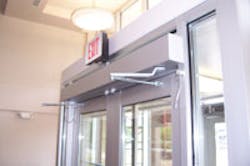Door & Gate Operators Opening New Doors To Profit
Door and gate operators are an integral access control component that might increase your profits. The demand for new door gate operators and the servicing of existing systems is a growing market.
Although a segment of the door operator market involves heavy duty, high power and hydraulics; a much larger market exists for the rest, which are mostly line voltage powered motors and low voltage control and safety subassemblies.
These systems provide for the convenience of customers, accommodate those with disabilities and provide security for parking facilities.
Because of ADA regulations, a door operator system may be mandated by the request of a single disabled individual. As the demographics of our country are shifting, the majority of the population is transitioning into the Senior League, and many of us have one or more disabilities.Door and gate operators are a real convenience for all of us, so long as they are operating properly and safely.
Door and gate operators involve several subassemblies, depending on the system. These include: the gate or door, locks, access control circuitry (switches, card readers, etc.) and safety accessories.
Doors and gates are either sliding, swinging or overhead.
Sliding door and gate systems are typically new installs. Sliding door kits are assembled on-site into a rough opening. The rough opening can be in an existing structure, or for a new construction.
Swinging door, gate and overhead systems are frequently retrofits which are applied to existing structures.
On pedestrian doors, some door operators are designed to offer the user an assisted opening of the door.
High traffic applications will sometimes incorporate inner and outer vestibule doors with sequenced or coordinated door operators which minimizes the time doors are open to manage heating and cooling, while still maximizing throughput.
Often, the building will provide handicapped buttons so that individuals requiring assistance can press a button to actuate the door opening.
Swinging door systems involve the least code issues and are relatively simple to install. Some low-energy models attach very much like a door closer; however, they do involve more attention to the mounting wiring and powering of the control.
You may also choose to sub out a portion of the installation if it requires more manpower than you can commit, skills you do not possess, or licensing or insurance coverage you don’t have.
Usually assembly of knocked down sliding door assemblies is a specialty project, just like installing a storefront would be. However, line voltage wiring is rarely part of your door operator contract, since providing the line voltage involves developing a branch feeder circuit off main panel, running the lines to the door area, and finally tying in the door operator to the line voltage. It’s a lot bigger deal than plugging into a receptacle.
A variety of control circuitry is usually incorporated into a door operator system, and a technician with either on the job experience or a little factory training should be able to manage a project with a little help from fellow employees.
Although all door operator projects have a lot in common, they each are also very unique. In the interests of the safety of those whole will be using the system, special attention must be given to all the specific safety issues associated with each project.
The door operator system will be comprised of the door/gates & operator; and auxiliary equipment used to trigger the opening of the door.
For commercial applications such as a store entrance, the doors will open immediately for any one or thing approaching them from either direction. In home improvement centers, I’ve noticed that sometimes signs will be placed over a door saying “Entrance Only” or “Exit Only,” but they’ll open anyway from either direction. The signs are an attempt to control traffic and minimize inventory shrinkage.
The door operator system is a self-contained entity, designed to operate autonomously. The system includes the doors/gates, and the motors to open them, and a controller to which external actuating, access control and safety devices are connected.
The tenants of the Life Safety Code shall always prevail; egress from the premises shall never be impeded, and the door operators shall have integral design features and be provided with additional auxiliary devices which protect the persons using the doors from being injured. The door operator system is supplied power, and connected to trigger any safety devices.
Special attention must be given to openings which utilize both door operators as well as locking hardware. Most door/gate operator systems do not provide physical security. Swinging doors can be manually opened without using the door operator. Sliding gates can be manually opened. Sliding doors can be pulled open, or have an integral breakaway feature which allows for emergency egress by simply pushing on the doors.
Whatever locking arrangements are applied to such openings, you cannot defeat the life safety features built into the openings.
The trigger is typically a momentary switch closure. Once triggered, the door operator goes into its sequence of opening the door, waiting a predefined ‘door opened’ time; them commencing the closing cycle. If a safety sensor connected to the door operator system detects an obstruction in the path of the door(s), the closing is delayed (or inhibited) until the presence sensor signals to the door operator that the obstruction is gone. Most door operators do not monitor trigger inputs while the door is still in the open position. Once the door open time has expired and the doors enter the close cycle, another trigger input will re-initiate the open cycle.
Most door operators are designed so that as long as a trigger signal (dry contact closure) is applied to the door operator system, the door/gate will remain open and the closing sequence will not start until contact closure goes to an open circuit, at which time the door operator counts out the programmed door open time, then enters the closing sequence.
For example, let’s say that the door operator is programmed for a 30-second door open time. The open trigger signal is 2 seconds; it takes the door operator 2 seconds to initiate the door close cycle once the input trigger is removed. Therefore, assuming that the door operator is working properly, and nothing is telling the door operator that there is an obstruction blocking the path of the doors; it will take at least 34 seconds for the door to go from a fully closed position, open, and then return to a fully closed position. The door takes a finite time to physically open and reclose.
For buildings where air conditioning, heating or the security of the occupants are mitigating factors, the door open time may be shortened substantially, provided that the presence and area presence sensors array was properly designed and is judiciously maintained. The baseline door open time is calculated based on three factors:
- The distance between the door open trigger and the opening. (This could be a card reader or approach sensor.)
- The speed of the doors when opened by the door operators.
- The time it will take the typical person using the door to get into the threshold of the door so that the presence sensors can take over the doors’ control and provide safe and convenient passage through the opening.
Typical Door Operator System Components
Activating Detection Sensors sense the approach of a pedestrian or vehicle, and trigger to door operator actuator. Such devices can include buried magnetic loop detectors for vehicle gates, or motion sensors for pedestrian and vehicle gate. The type, range, and sensitivity of the detectors are determined by each application’s specific requirements.
Presence Sensors sense when some one or something is obstructing the opening and therefore the gate or door should remain open until the obstruction is no longer in the path of the door or gate. Typically the presence sensors will be ‘Beam’ type devices which create horizontal protection patterns in the door/gate threshold.
Door/Gate operator controllers have terminal points designated for the connection of such devices, and the controllers are designed so that their operation and timing sequences are coordinated around the signals they get from the sensors connected to them. Approach sensors and safety sensors are the eyes of the door operator. Unless the door or gate being controlled actually encounters an obstruction, without signals form the sensors, the door/gate operator is ‘blind’
Area Presence Sensors detect persons or objects approaching (but not yet in the path of the door or gate), and signal the operator circuitry the same way the presences detectors do. Area Presence sensors give the door operator extra time to react, and provide redundant safety for end-users.
For example, if the beam type sensors fail to detect the person; or if the person is still approaching the opening, or if the beams themselves are inoperative, the area presence detector might avert a catastrophe.
Safety control mats (pressure mats) provide not only the traction and cleaning benefits of a traditional floor mat, but also send a signal to the door operator.
For a swinging door, if the mat is on the swing side of the door, that is beneath the swing of the door, the mat can signal the door operator the presences of a person is in its path, and inhibit it from opening. If the mat is on the push side of the door, it can serve as an approach sensor if the door is in the closed position, and also as a presence sensor if the person steps on it while the door is opened.
Knowing Act Door Activation is used in situations where the individual wishing to transgress the door must deliberately press a button, or present an access credential to a reader in order for the for door to open.
Entrapment Protection Devices connect to doors or door vestibule systems to prevent an individual or vehicle from being trapped or confined by a door system.
Tim O'Leary
Tim O'Leary is a security consultant, trainer and technician who has also been writing articles on all areas of locksmithing & physical security for many years.






